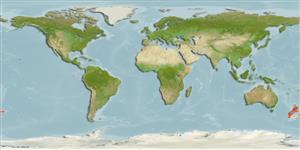Common names from other countries
Environment: milieu / climate zone / depth range / distribution range
Sinh thái học
Tầng nổi; Mức độ sâu 0 - 500 m (Ref. 275). Temperate, preferred 16°C (Ref. 107945); 39°S - 56°S, 165°E - 176°W (Ref. 120902)
Southwest Pacific: New Zealand; Known from the South Island, the southeast coast of the North Island, also from south of the Auckland Island and west to the Chatham Islands.
Length at first maturity / Bộ gần gũi / Khối lượng (Trọng lượng) / Age
Maturity: Lm ? range ? - ? cm Max length : 42.0 cm ML con đực/không giới tính; (Ref. 275); Khối lượng cực đại được công bố: 1.8 kg (Ref. 275); Tuổi cực đại được báo cáo: 1.00 các năm (Ref. 127344)
Life cycle and mating behavior
Chín muồi sinh dục | Sự tái sinh sản | Đẻ trứng | Các trứng | Sự sinh sản | Ấu trùng
Members of the class Cephalopoda are gonochoric. Male and female adults usually die shortly after spawning and brooding, respectively. Mating behavior: Males perform various displays to attract potential females for copulation. During copulation, male grasp the female and inserts the hectocotylus into the female's mantle cavity where fertilization usually occurs. Life cycle: Embryos hatch into planktonic stage and live for some time before they grow larger and take up a benthic existence as adults.
Roper, C.F.E., M.J. Sweeney and C.E. Nauen. 1984. (Ref. 275)
IUCN Red List Status (Ref. 130435)
CITES status (Ref. 108899)
Not Evaluated
Not Evaluated
Human uses
Các nghề cá: Tính thương mại
FAO - Các nghề cá: landings, species profile | FishSource | Biển chung quanh ta
Các công cụ
Các nguồn internet
Estimates based on models
Preferred temperature
(Ref.
115969): 8 - 14.5, mean 11.8 (based on 53 cells).
Thích nghi nhanh
Trung bình, thời gian nhân đôi của chủng quần tối thiểu là 1.4 - 4.4 năm (K=0.25).
Vulnerability
Low to moderate vulnerability (32 of 100).
